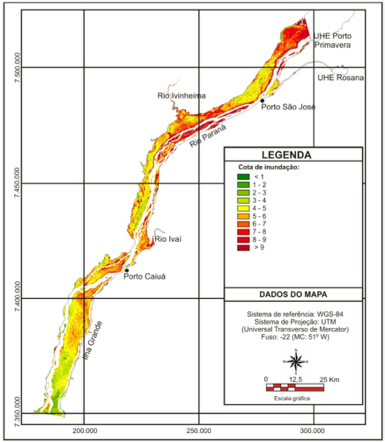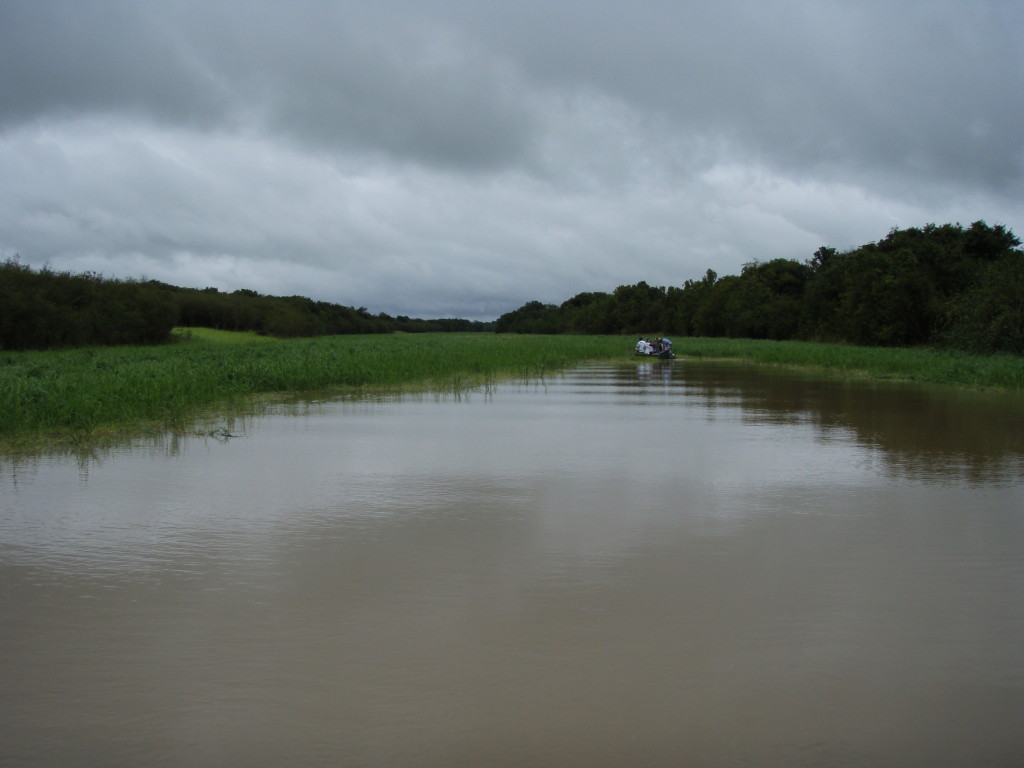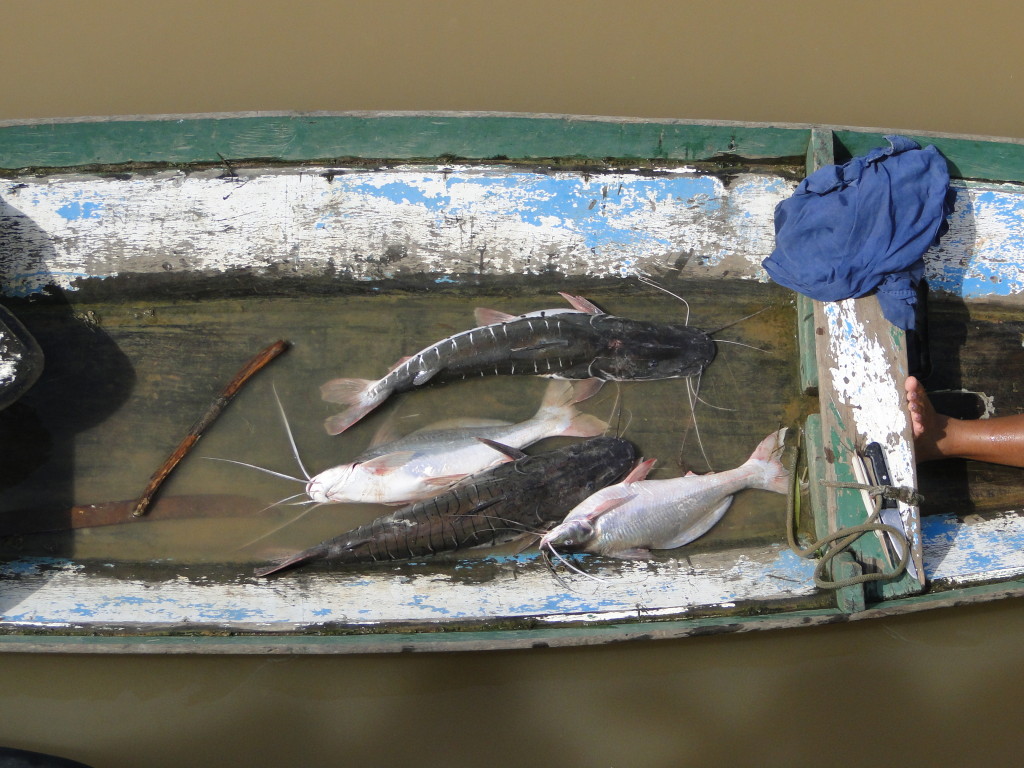Community and Food Web Ecology
Development of an Individual-based simulation model for food web dynamics in response to hydrology in river–floodplain ecosystems
Pitagoras Piana (UEPO), Eduardo Cunha (UEM), Henrique Giacomini (UT), Kirk Winemiller (TAMU), Angelo Agostinha (UEM), and Luiz Gomes (UEM)
Several international groups of scientists are trying to model hydrology, fisheries, and human welfare associated with large rivers for which major new dams are being constructed for generation of hydroelectric power. For example the Mekong River in Southeast Asia is facing a new set of impacts (hydroelectric dams, overfishing, climate change), and there is much regional and international attention being given to the interrelationships of natural and human systems. There is a need to understand and predict tradeoffs involving ecosystem services (such as nutrient dynamics, water quality, and fisheries and agricultural production) as a function of hydrologic regimes so that these can be understood and evaluated by stakeholders. The Amazon Basin is another region of the world experiencing this major challenge. The Upper Paraná Basin in Brazil already has been extensively modified from construction of numerous hydroelectric dams.

With support from the Brazilian government’s Science Without Borders program, a team of Brazilian and US ecologists are creating a model for tropical floodplain river fish communities — blending landscape features and hydrology as inputs with key features of model developed by Giacomini et al. (2013) that adopts an individual-based, process-oriented approach to simulate fish life history strategies and community dynamics. The model is complex, but this complexity allows simulation of realistic features of species and ecosystem dynamics. For example, effects of hydrological pulsing (pulsing of environmental quality affecting reproduction, feeding, growth) can be simulated according to conditions before and after dam construction. Most tropical rivers have been poorly studies and lack detailed information. In contrast, the Upper Paraná River system in Brazil is well studied and data rich. The initial model will be created to predict dynamics for the Paraná River, with extensive opportunities for model testing. The goal is to create robust model components that can easily be modified to simulate other rivers. To be accessible for other researchers, the model code is being written in the R programming platform.
This effort is a collaboration among researchers at Texas A&M University, Universidade Estuadual de Maringá, Universidade Estadual do Paraná do Oeste, University of Toronto, and others.
Giacomini, H.C., D.L. DeAngelis, J.C. Trexler, and M. Petrere, Jr. 2013. Trait contributions to fish community assembly emerge from trophic interactions in an individual-based model. Ecological Modeling 251:32-43.
Baseline survey of the Lower Xingu River rapids, Brazil: a highly diverse, globally unique, and immediately imperiled ecosystem
Mark Sabaj and John Lundberg (Academy of Natural Sciences of Philadelphia, and Drexel University), Nathan Lujan (Royal Ontario Museum), Lucia Rapp Py-Daniel and Jansen Zuanon (Instituto Nacional de Pesquisas da Amazônia), Leandro Souza and Tommaso Giarrizzo (Universidade Federal do Pará), and Kirk Winemiller and Dan Fitzgerald (TAMU)
This project focuses on the Xingu River, which is the Amazon’s largest clear-water tributary (i.e., high water transparency with low sediments and tannins), and is distinguished by an abundance of rocky, fast-water habitats and a highly diverse and endemic fauna, much of which is specialized for life in rapids. High-gradient rivers face the increasing global threat of conversion to hydroelectric reservoirs, and the Xingu is no exception. Construction has begun on a series of dams that will massively alter the Lower Xingu by dewatering some portions and impounding others. These dams will be concentrated in Pará State, Brazil where the Xingu courses through a 130 km maze of high-energy rapids that are the focus of this proposal.
This project examines the extent to which the Lower Xingu River rapids support greater biodiversity than adjacent stretches of the Xingu and comparable rapids elsewhere in tropical South America, the function of the rapids as a faunal barrier between the upper and Lower Xingu watershed, the physical habitat variables that best explain faunal distributional patterns, and the functional diversity of local species assemblages in terms of trophic characteristics from both contemporary and evolutionary perspectives.
The project will contribute to a much-needed general understanding of the contribution river rapids make to tropical biodiversity and productivity, and the global importance of these imperiled and ecologically heterogeneous upland ecosystems. Field expeditions will be conducted during different river level stages to make fish collections prior, during, and after completion of the first dam. The team also will collect samples of fishes, mollusks, decapods and aquatic insects, samples for the isotopic determination of community trophic structure, and data on water chemistry and habitat diversity. In addition to providing an enhanced, permanent record of native biodiversity, the whole specimens, tissues, and associated data will address questions about the evolution and ecology of life within the Lower Xingu and will provide an environmental baseline to assess future dam impacts. Evolutionary and ecological processes will be examined for selected fish taxa; and seasonally comprehensive data on physicochemical parameters and community trophic pathways will be collected so that productivity–habitat–biodiversity relationships may be understood immediately prior to large-scale alterations from dam construction. This project is funded by the National Science Foundation, Instituto Nacional de Pesquisas do Amazônia, and Universidade Federal do Pará.



Influence of deforestation on fish communities and fisheries in the Amazon floodplains
Carol Arantes, Kirk Winemiller, Miguel Petrere (Universidade Estadual Paulista), David McGrath (Instituto de Pesquisa Ambiental da Amazônia)
This study aims to improve understanding and model the influence of deforestation on fish communities and fishery yields in the lower Amazon River. To do this, we are using indicators of standing biomass and fish growth to assess population and community status, and stable isotope methods to estimate energy sources supporting fishes exploited by commercial and subsistence fisheries. Field research is being conducted during four phases of the hydrological cycle and along a gradient of impact to the floodplain (from the most degraded to the most pristine) in the Lower Amazon near the city of Santarem. The spatial units of analysis are floodplain lake systems. Floodplain forest cover is being estimated for each sample lake system. Fishes are being sampled using gillnets of varying mesh sizes in order to capture a broad range of fish species and sizes classes normally harvested in regional fisheries. Environmental characteristics of habitats within each lake system are assessed, and analyses will integrate data for local watersheds, aquatic habitat geomorphology, fish stocks, and community structure using multivariate modeling methods. This project is funded by the Conselho Nacional de Pesquisa e Desenvolvimento, Brazil.

